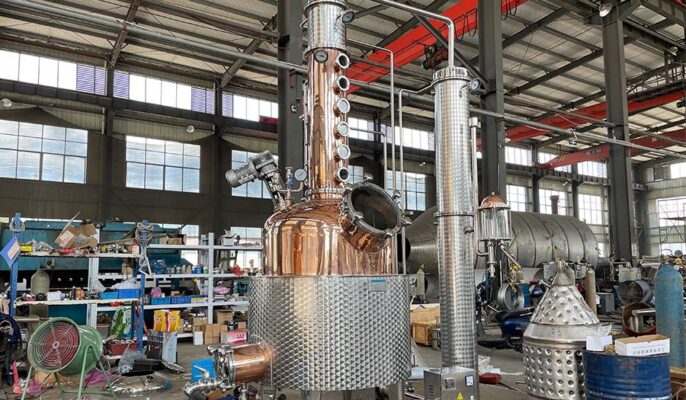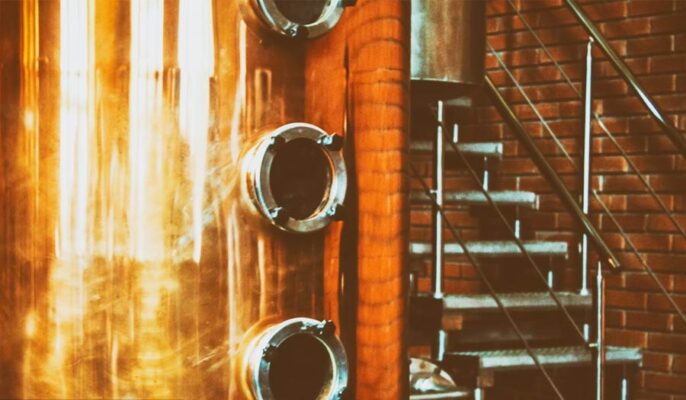The selection and configuration of distillation equipment in brewing high-quality gin is essential. In the production process of Gin, the choice of equipment directly affects the quality, flavor, and production efficiency of the wine. The distillation process not only involves precise treatment of raw materials but also requires efficient equipment to ensure the success of each step. From the distillers to the condenser, the functions and performance of each device will have a profound impact on the final product.
What is Gin?
Gin wine is a kind of harmonious wine based on grains, known for its unique gin flavor. The main raw materials of gin wine are grains (such as barley, wheat, corn, or rye), which are transformed into alcohol after fermentation. Some recipes may also use fruit or other plant materials. gin is the iconic ingredient of gin, giving it a unique aroma and flavor. gin a small fruit with a fresh and slightly pine flavor. The fermented liquid is distilled through the distillers and usually requires two distillations. The original wine produced by the first distillation is called “Neutral Spirit”. When the second distillation is distilled, add gin and other spices (such as fragrant leaves, cinnamon, orange peels, etc.) to extract the flavor.

List of Gin Wine Winery
Suguring and équipement de fermentation
Before starting distillation, you need to make malt paste and ferment it to start producing alcohol. Whether you want to ferment corn, wheat, barley, or any other grain, you should have a suitable container to complete this work.
- Eat juice barrel: Outlet juice barrel is the starting point of everything. Here, you mix the grain (grinding malt) with water at a controlled temperature. This mild heating can cause glycation and convert starch into fermented sugar. This barrel has a false background with a sieve on it to separate the waste grain from the liquid. In this way, you can get a fermented ocean juice.
- fermentation tank: The fermentation tank is a large container. The yeast added to the malt juice will ferment the sugar into alcohol. During the fermentation process, it is very important to control the temperature and maintain it for several days. The fermentation tank also needs a pressure release valve to continuously release the gas generated by fermentation. According to how much you plan to produce in the brewing plant, you may need multiple fermentation tanks and fill in the staggered timetable.
Équipement de distillation
Distillateur
The distiller is the core equipment produced by gin wine, which is responsible for evaporating and separating the alcohol in the fermented liquid. There are several common distillers:
- Copper distillers: Because of its excellent thermal conductivity and the ability to remove impurities, copper materials are widely used in the production of high-end Du Songzi wine. Copper can also react with sulfide in alcohol to improve the quality of alcohol.
- Stainless steel distillers: This distillery is durable, easy to clean and the cost is relatively low, suitable for large-scale production. Although its thermal conductivity is not as good as copper, its stability and corrosion resistance make it a popular choice in modern wine making.
- Mixed material distiller: Some manufacturers choose the design of copper and stainless steel, which not only retains the advantages of copper but also takes into account the durability of stainless steel.
Chaudière
The boiler is the core part of the distillation process, which is used to heat the fermented liquid. By heating, alcohol, and other volatile components are evaporated into steam. Copper or stainless steel is usually made of copper or stainless steel. Copper has excellent thermal guidance and the ability to remove impurities, while stainless steel is widely used due to its durability and easy cleaning.
Condenseur
The role of the condenser is to cool the steam and convert it into a liquid. The performance of the condenser directly affects the collection efficiency of alcohol. The pipe condenser uses long pipelines for steam cooling. The structure is simple and suitable for small equipment. The plate condenser uses multiple sectors for heat exchange, with a small size and suitable for places with limited space.
Division column
Division columns are used in continuous distillation equipment to further separate the ingredients in the steam, and accurately separate different volatiles through multiple fractional segments. Including multiple towers, fillers, or grilles to improve fractional effects. The design height and the type of filler can affect the purity and efficiency of distillation.
Filtre
You can choose to filter it before storing distillation products. You can use a bag filter, filter, or filter paper to remove particulate matter, clarify dark wine, and add gloss to white wine.

How do you choose Gin Wine distillation equipment?
Dimensive equipment size
Select the right equipment according to the production scale. Small devices are suitable for environments with limited space, and large-scale equipment requires more space. Ensure that the size of the selected equipment is suitable for your production needs while leaving enough space for operation and maintenance. The layout of the equipment reasonably is optimized to optimize the workflow. It usually includes distillers, condensers, collectors, seasoning devices, etc. Layout should take into account the connection, operation channels, and maintenance space of equipment.
Échelle de production
If you plan to make small batch production or handmade brewing, it is recommended to choose a smaller distiller, such as a batch distillery or a small copper distiller. These devices are suitable for making unique flavors and easy adjustment. For medium and large-scale production, continuous distillers or high-efficiency stainless steel distillers are more suitable, and they can provide continuous production capacity and higher distillation efficiency.
Equipement
Copper distillation equipment: Copper has excellent thermal guidance, which can better remove impurities and improve the flavor of wine. Copper distillers are suitable for the production of high-end Dutong seeds, but they need to be maintained regularly to prevent copper oxidation.
Stainless steel distillation equipment: stainless steel is durable and easy to clean, suitable for large-scale production. Although it cannot react with copper, its stability and corrosion resistance make it a common choice for modern production.
Mixed material distillation equipment: combined with the advantages of copper and stainless steel, which is suitable for high-performance and durability production environment.
Type de distillation
Batch distillers: Suitable for small batch production and traditional technology, which can give wine unique flavors. Suitable for fine seasoning and experimental production.
Continuous distillers: Suitable for large-scale production, continuous and efficient distillation, and suitable for occasions that require high production capacity and stable quality.
Vacuum distillers: used to distill at low temperatures to reduce losses of thermal sensitive ingredients, and it is suitable for production with high requirements for flavors.
Easy-to-use cleaning
Choosing distillation equipment with automatic cleaning functions can save time and ensure that equipment is hygienic, avoiding the impact of pollution and dirt on wine. Copper equipment may require more maintenance, and stainless steel is more durable.
Budget
The cost of distillation equipment is one of the key factors for selection. High-end copper distillers are high in price, but can provide better flavor; stainless steel distillers are low in cost and suitable for large-scale production. Long-term investment needs to consider the durability and maintenance costs of the equipment, and selectively select equipment to ensure the return on long-term investment.
Supplier service
When choosing a suitable Du Songzi wine distillation equipment, the service quality of the supplier is a key consideration. Excellent suppliers not only provide high-quality equipment but also provide support in the process of use, maintenance, and upgrade after purchasing. Groupe Micet will provide you with a detailed requirements analysis. According to your production scale, the budget will customize the most suitable distillation equipment for you.
FAQ
How to determine what type of équipement de distillation I need?
The type of device mainly depends on your production scale and needs. Small batches of production are usually suitable for batch distillers, and they can provide unique flavors. For large-scale production, continuous distillers are more suitable because they can efficiently handle large amounts of fermentation liquid. When choosing a suitable device, you need to consider your budget and the flexibility of production.
How do you choose the appropriate distillation equipment size?
The size of the equipment should be selected according to the production scale and space conditions. For small-scale production, choose equipment with moderate capacity to avoid waste. Large-scale production requires large equipment to ensure production efficiency.
How important is the control system of distillation equipment?
The control system is very important, it affects the operating efficiency of the device and the quality of the final product. Modern equipment is usually equipped with temperature control systems, automated control, and data record functions. These systems can provide accurate temperature and pressure control to improve the consistency and stability of production.
How to deal with the maintenance and cleaning of distillation equipment?
The maintenance and cleaning of distillation equipment is very important, which can affect the sustainability of production and the quality of wine. Choose a device with an automatic cleaning system to simplify and maintain work. The regular inspection of the equipment is maintained and cleaned by the manufacturer’s recommendations to ensure the long-term stable operation of the equipment.




